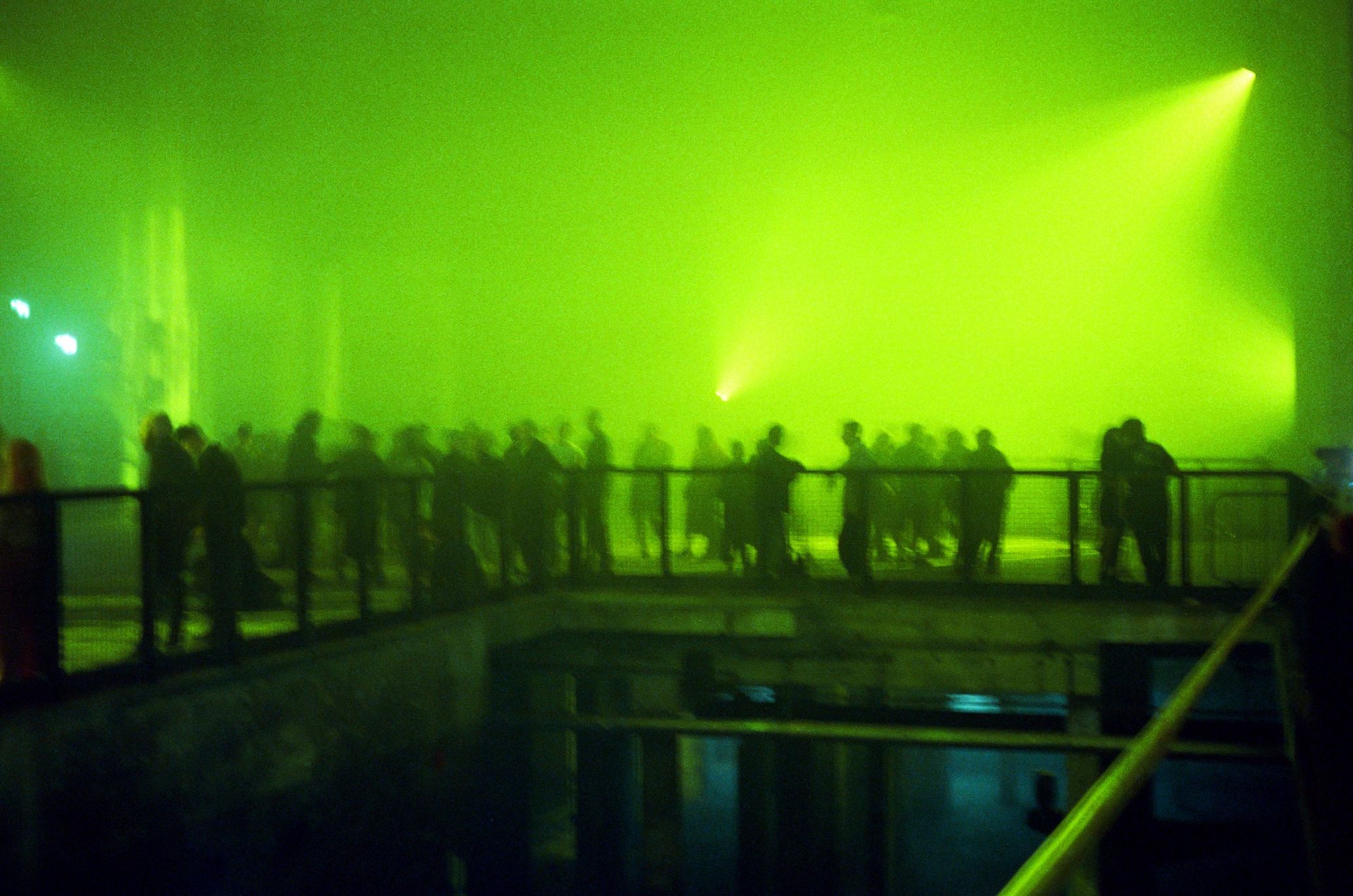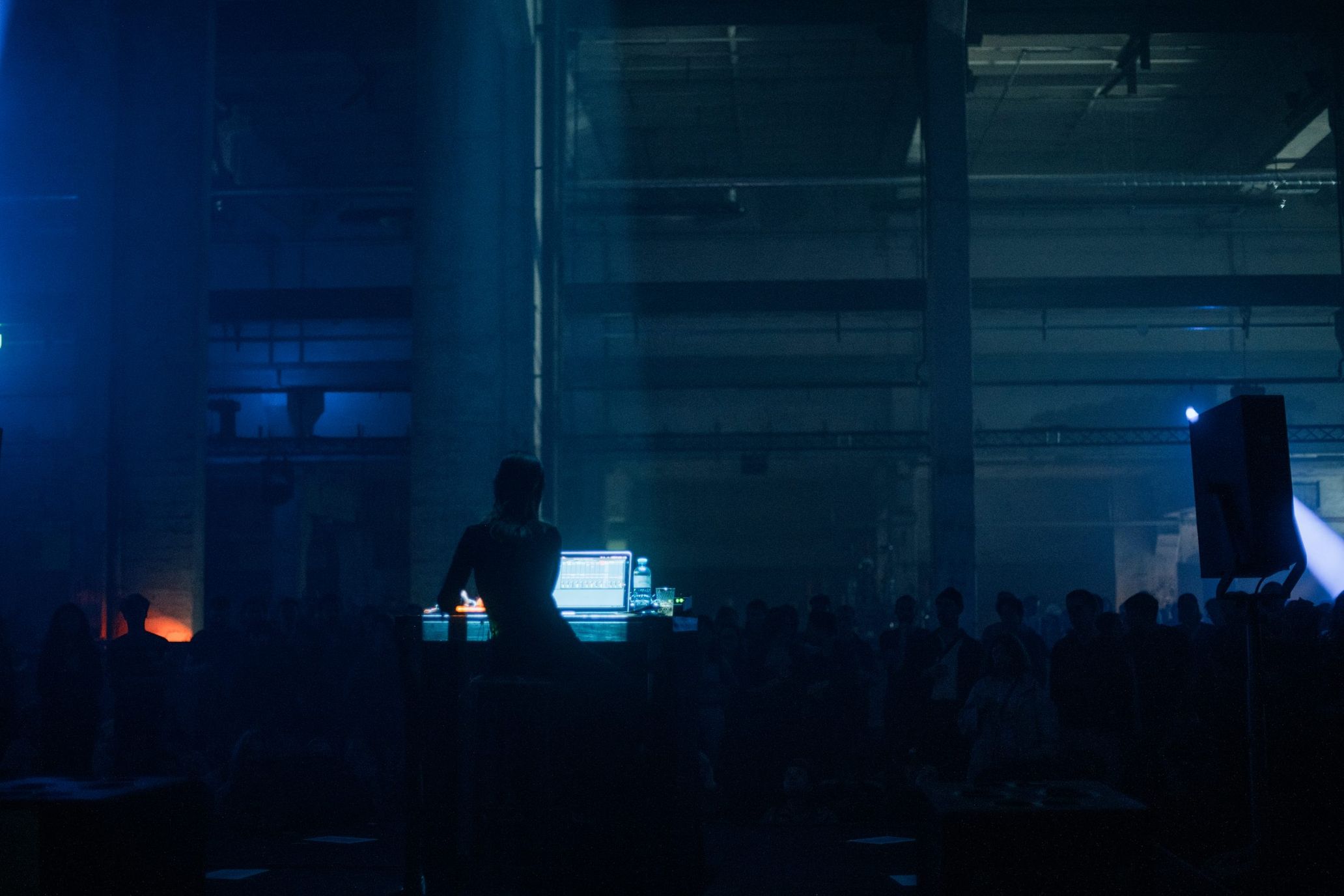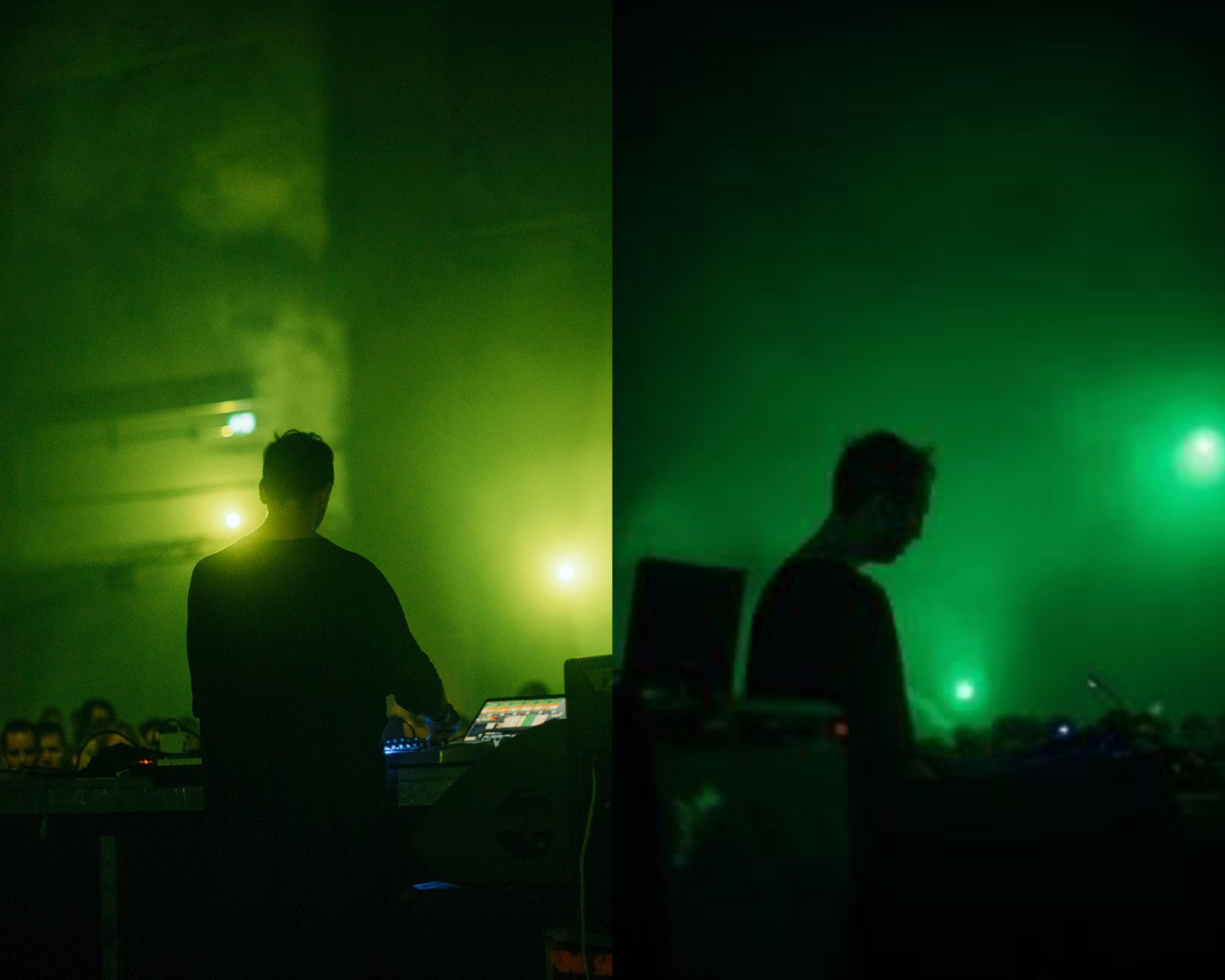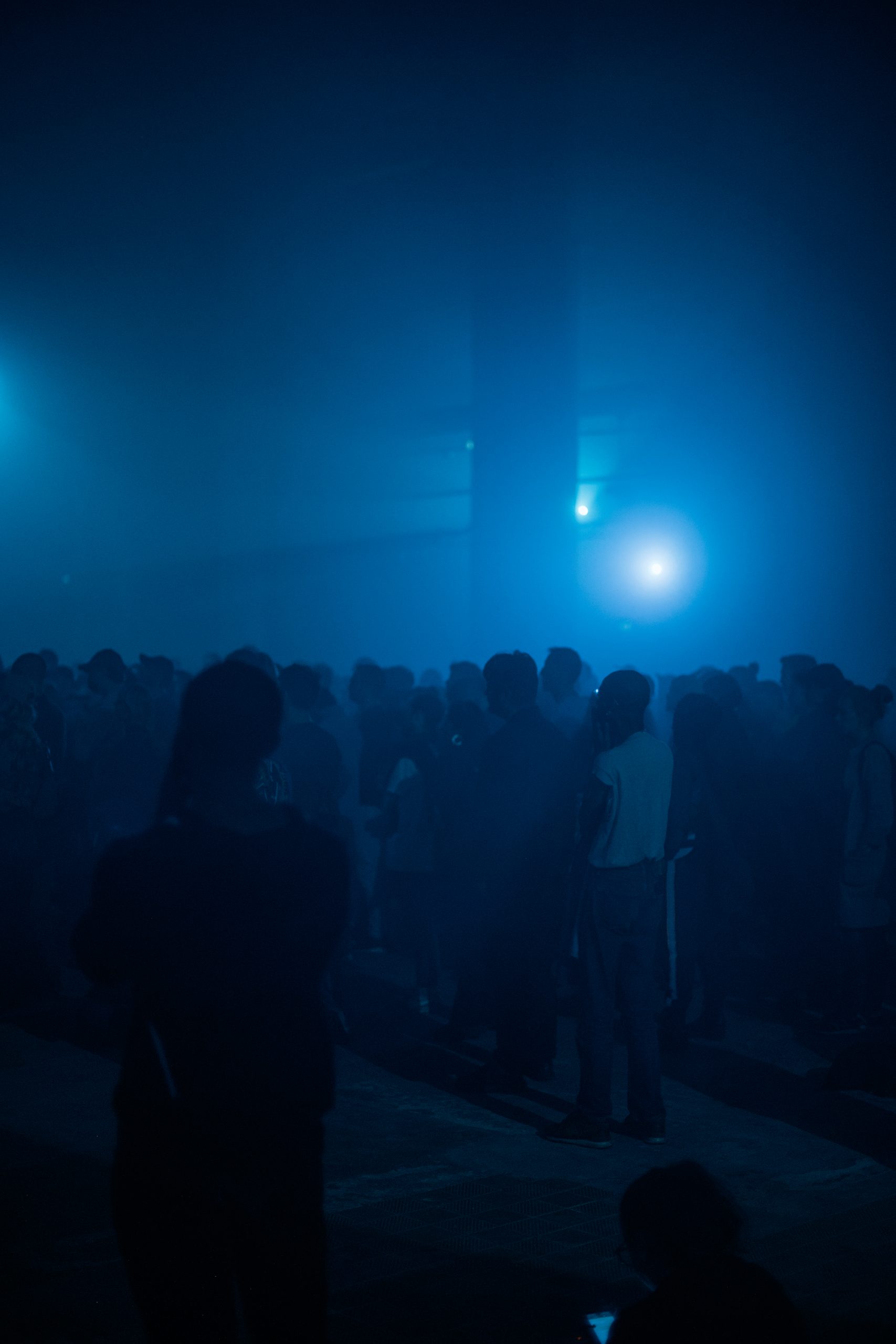On December 8th, 2021, Berlin announced that it would be banning dancing in clubs once again.
The art and music scene has many difficult decisions ahead. In any case, I’d like to revisit a report of an underground event in Berlin that took place in the summer and fall of 2021, when the lockdown restrictions were eased.
Since its establishment in 1982 as a “festival for experimental music and images,” Berlin Atonal has been an annual event. That is, until last year, when the coronavirus pandemic forced the city into lockdown. Berlin Atonal may be the biggest festival that regularly connects Berlin’s art and music scene. For a report on the art portion of the event, please refer to part 1 of this series. In this article, I’ll focus on the concert portion of Berlin Atonal, which featured Tim Hecker as a headliner.
The venue had a coldness to it. This isn’t surprising: the site was formerly a power station and features a ceiling that stretches far overhead. The fact that this space is still used as a venue for art events is a noteworthy point about Berlin. Still, after a year where events were far and few between, there was a quiet feeling of excitement in the air. After all, we were about to witness a festival that would once again serve as a connection between the underground and art scene. The people who had been looking around the venue were killing time outside or doing as they pleased, but it didn’t feel like they were staving off boredom. Although the event was running behind schedule, everyone seemed to be in no particular hurry; rather, they seemed to be thoroughly savoring the time. Just as I thought that the crowd had grown larger, the time came without warning.
A hard, rhythmless beat echoes through the hall
It must have been about an hour past the originally scheduled start time. Quietly— but surely—Perila began playing heavy bass, as if to check the groove of the entire venue. Until then, everyone had been engaged in conversation, but Perila’s sounds pulled them in. The audience began exchanging looks with one another, as if to confirm, “It’s started.” It was as if Perila was standing on the border of the sonic universe, trying to delicately depict a profound universe and give context to this space. And just as the audience was sinking deeper into the atmosphere of the music, she gently stepped forward, bowed her head, and left. It’s safe to say that there couldn’t have been a better beginning.
The next performer was Berlin producer Ziúr. Accompanying the bass-heavy performance was a guest appearance by Kiani del Valle, a choreographer who has caught the attention of the world. The visual impact was striking: Ziúr aggressively approached the audience, not only from her sonic universe but also from a visual and bodily perspective. As she swayed her body to the sound, the vibrations reacted to Ziúr, who interweaved her sonic universe and the audience. It was amazing how this reaction led to an even more experimental approach. The two women expressed their thanks many times. On the screen, Ziúr’s trance-like expression was illuminated by beautiful lights.
In contrast to the hard, heavy sounds that rang throughout the industrial space, this straightforward and powerful approach was striking. And as 9 PM rolled around, at last, the MC announced Tim Hecker’s entrance onto the stage, and the venue erupted into applause as if to express their respect for both Hecker and Ziúr.
Tim Hecker’s mysterious and profound sonic universe
Just before starting, Tim let out a small smile. Then, he played a minimal number of notes, layering them one by one. The symphonic melodic line steadily became clearer, and the heavy bass enveloped the venue like an iron curtain. After a while, I could hear the bass echoing through the industrial, naked concrete venue from afar. The sounds were heavy, reverberating like cracks of thunder. These vibrations enveloped my entire body.
It felt as if we were in a secluded cave. The space was filled with expectation as if the audience was eagerly awaiting the moment when this heavy sound would play. People closed their eyes and swayed their bodies.
Meanwhile, the gagaku (old Japanese court music) refrain of the striking song, “This Life,” began to echo through the venue. The time it took to walk on the border between Konoyo (this world) and Anoyo (the world over there), about 15 minutes, was like a ritual. The sound, which was too sad to call paradise, beckoned towards another world. Ancient string instruments reverberated over and over, permeating deeply into every cell of my body. It felt strange that in 2021, in Berlin, the sounds of gagaku were sincerely being delivered to the audience’s ears.
Nothing in the performance could be described as a rhythm. Instead, people sat and closed their eyes amid the continuous fluctuations and soundscape, or swayed their bodies to their own rhythm. Amid the sounds that blended the values of East and West, the border between people—which was noticeable even without closing one’s eyes—became blurred in the fog that filled the room. Each of us bathed in the sound that emerged.
Perhaps the combination of the sound and the audience’s memories, and the audience’s immersion in their own thoughts, amplified the images that emerged from this sonic universe. In that sound, we found something, exploring feelings that we’d never shared before. I muttered to myself, “This is like a kind of sonic church.”
After nearly 10 minutes of the gagaku echoing through the venue, the song that followed felt as if it were inviting us to another world—like the title of the EP, Step Away to Anoyo. I felt as if my body existed within this world, but my consciousness was being guided somewhere far away. Or maybe it was like the universe of stringed instruments and sound textures were a blizzard in the tundra, coolly numbing my brain. Was it the calmness of the venue? Or the magical chill manufactured by Hecker’s sonic universe? I was lost in a fantasy where my body was numb, unable to move on a snowy mountain. Just as I nearly reached a place of no return from this solitary universe I was pulled into, the synth sounds from “Music for Tundra” and Hecker’s newest album, The North Water, poured forth as if to illuminate our present world. Then, the same refrain from the beginning rang out, as if to rein us in from the border of the cold universe back to reality. The sounds died down as if to gradually return our consciousness to the present world.
For nearly 20 years, Tim has persisted as an artist who makes boundary-breaking music that can’t always be categorized as noise or drone music. He has always been a pioneer in the field of ambient and drone culture, not only with his construction of sound collages but also with his church-music approach to his composition, which leads listeners into a warm, fantasy world.
We never tire of stepping into the abyss of Hecker’s sonic universe, which he leads us into again and again. And then we disperse, going back to our lives. We bring something back with us, and something within us has been purified. As long as there is a place for expression and people who continue to gather there, the practice of appreciating and experiencing art will remain unchanged—no matter what happens in the post-pandemic world. This was a night that confirmed that for me.
Direction Kana Miyazawa
Translation Aya Apton






